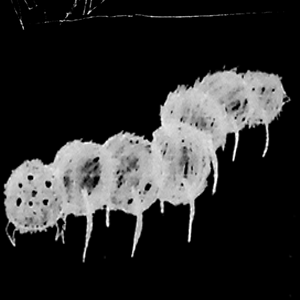Cenode
Pedibus Matris


The Cenode is a species of aquatic insectoid native to Gymir. This creature is unlike other species within Ocean Sector 3 in that it gives semi-live birth. It grows its spawn from the thoraces. One thorax can contain up to 3 children. The Cenode grows thoraces throughout its lifespan and usually peaks at around 13, though on rare occasions up to 25 have been seen. This is most likely due to infertility in the specimen. When a child is larger than the thorax that contains it, the thorax containing it will stretch rapidly until it eventually ruptures, releasing the child. This has the downside of putting high pressure on nearby amniotic sacs and potentially making them burst while their spawns are still fetal. After giving birth, the amniotic fluid that was once inside the thorax will provide adhesion to the two, now separated and damaged parts of the mother Cenode. This can take from 1 day to an entire week. Though this report has been referring to Cenodes as females, they are, in fact, asexual and use a form of multicellular fragmentation to reproduce. The Cenode also seems to have a symbiotic relationship with the Carcass Pitcher. It has been seen consuming the spores that the Pitcher produces, despite their extreme toxicity. It is unknown if it is naturally immune to the toxin or has evolved to find nutrition in it. In exchange for the spores, the Cenode brings the corpse of a creature to feed to the Pitcher.
Cenodes are typically docile, though approaching it while it is resting may anger the Cenode and cause it to start attacking. Cenodes are generally slower than the average human in the Gymir Exploration Specialized AMS, though they are exceptionally good at corners and can catch up easily if you decelerate at any point. Do not, under any circumstances, approach a Cenode when it is in postpartum, as it will put you and the Cenode in great danger. The Cenode may be startled and move, disrupting the amniotic fluid’s adhesion process and causing permanent damage to the Cenode's body. As for you, there is a high likelihood that exposure to its amniotic fluids will result in what is commonly known as Cenodic Meltdown Syndrome. Symptoms may include, but are not limited to: acute renal failure, severe abdominal bloating, and a general burning sensation of the internal organs. This is caused mainly by inhaling both the amniotic fluids of the Cenode, which contain flesh-eating bacteria. and its main source of nutrients, the Carcass Pitcher’s spores.